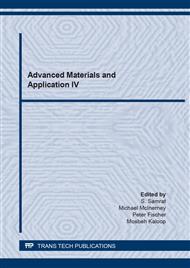[1]
T. Haga, K. Takahashi, H. Watari: Semisolid strip casting using a vertical type twin roll caster, Materials Science Forum 426 (2003) 477-482.
DOI: 10.4028/www.scientific.net/msf.426-432.477
Google Scholar
[2]
T. Haga, K. Takahashi, M. Ikawa: A vertical type twin roll caster for aluminum alloy strip, J. Mater. Process Technol. 140 (2003) 610-615.
DOI: 10.1016/s0924-0136(03)00835-5
Google Scholar
[3]
T. Haga, M. Ikawa, S. Kumai: A high speed twin roll caster for aluminum alloy thin strip, Trans. Mat. Res. Soc. Japan Vol. 29 (2004), pp.1823-1828.
DOI: 10.1299/jsmeintmp.2005.2_5
Google Scholar
[4]
T. Haga, Development of a twin roll caster for light metals, J. Achiev. Mater. Manuf. Eng. 43(2010) 393-402.
Google Scholar
[5]
K. Komeda, T. Haga, S. Kumai, High speed twin roll casting of Al-Mg alloys, Advanced Materials Research 154-155 (2011) 1544-1548.
DOI: 10.4028/www.scientific.net/amr.154-155.1544
Google Scholar
[6]
T.Haga, Strip Casting of Recycled Aluminum alloys by a Twin Roll Caster, Waste and Biomass Valorization 3,4(2012) 419-424.
DOI: 10.1007/s12649-012-9153-3
Google Scholar
[7]
Y. Li, C. He, J. Li, Z. Wang, D. Wu, G. Xu, A novel approach to improve the microstructure and mechanical properties of Al-Mg-Si aluminum alloys during twin-roll casting, Metals 13,1713(2020).
DOI: 10.3390/ma13071713
Google Scholar
[8]
Z. Xu, S. Wang, H. Wang, H. Song, S. Li, X. Chen, Effect of cooling rate on Microstructure and properties of twin-roll casting 6061 aluminum alloy sheet, Metals 10,1168(2020).
DOI: 10.3390/met10091168
Google Scholar
[9]
R. Cook, P. G. Groock, P. M. Thomas, D. V. Edmonds, J. D. Hunt: Development of the twin-roll casting process, J. Mater. Process. Technol. 55(2) (1995) 76-84.
DOI: 10.1016/0924-0136(95)01788-7
Google Scholar
[10]
M. Cortes, Pechiney- Jumbo 3 CM super ((R)) the new demands of thin strip casting, Light Met. (1995) 1161-1164.
Google Scholar
[11]
B. Taraglio, C. Romanowski, Thin-gage/high-speed roll casting technology for foil production, Light Met. (1995) 1165-1182.
Google Scholar
[12]
A. I. Nussbaum, Three-state-of-the-art Thin –gage high-speed roll caster for aluminum alloy sheet products, Light Met. Age, 12 (1996) 8-19.
Google Scholar
[13]
O. Daaland, A. B. Espedal, M. L. Nedreberg, I. Alvestad, Thin gage twin-roll casting, process capabilities and product quality, Light Met. (2016) 989-996.
DOI: 10.1007/978-3-319-48228-6_125
Google Scholar
[14]
A.I. Nussbaum, Three-state-of-the-art Thin –gage high-speed roll caster for aluminum alloy sheet products Part III, Light Met Age, 55(1997)34-39.
Google Scholar
[15]
O. Daland, A.B. Espedal, M.L. Nedreberg, I. Alvestad, Thin gage twin-roll casting, process capabilities and product quality, Light Met. (1997) 745-752.
DOI: 10.1007/978-3-319-48228-6_125
Google Scholar
[16]
P.Y. Menet, R. Cayol, J. Moriceau, Pechiney Jumbo 3CM TM, start-up of the Neu-Brisach thin strip caster, Light Met. (1997) 753-756.
Google Scholar
[17]
P.M. Thomas, P.G. Grocock, J.M. Bouzendorffer, Dynamic strip caster-An update on the operation of the roll caster at Eurofoil, Metall Plant Technol. Int. 20 (1997) 44-52.
Google Scholar
[18]
S.Hamers, D.Smith, C.Romanowski, G.Yildizbayrak, B.Taraglio, Twin roll casting of aluminum at 2.5mm gauge. Production experience and process improvement, Light Met. (1999)931-937.
Google Scholar
[19]
J.Benedyk, Thin strip casting for aluminum alloy sheet applications developed by Pechiney at Neuf-Brisach, Light Met Age 59(2001)28-30.
Google Scholar
[20]
S.Hamer, C.Romanowski, B.Taraglio, Continuous casting and rolling of aluminum: Analysis of capacities, products ranges, and Technology, Light Met Age 60(2002)6-17.
Google Scholar
[21]
M.Duendar, OE.Keles, B.Kerti, N.Dogan, Crystallographic texture development of twin-roll cast aluminum strips, Light Met. (2004)723-724.
Google Scholar
[22]
Ch. Gras, M.Meredith, J.D. Hund, Microdefects for mation during the roll casting of Al-Mg-Mn aluminum alloys, J.Mater.Process.Technol. 167(2005)62-72.
DOI: 10.1016/j.jmatprotec.2004.09.084
Google Scholar
[23]
T. Yamashiki,T. Haga,S. Kumai,H. Watari, Investigation of the influence of the roll surface on the cast strip at the casting using a vertical type high speed twin roll caster, Advanced Materials Research 184-185 (2012) 271-276.
DOI: 10.4028/www.scientific.net/amm.184-185.271
Google Scholar


